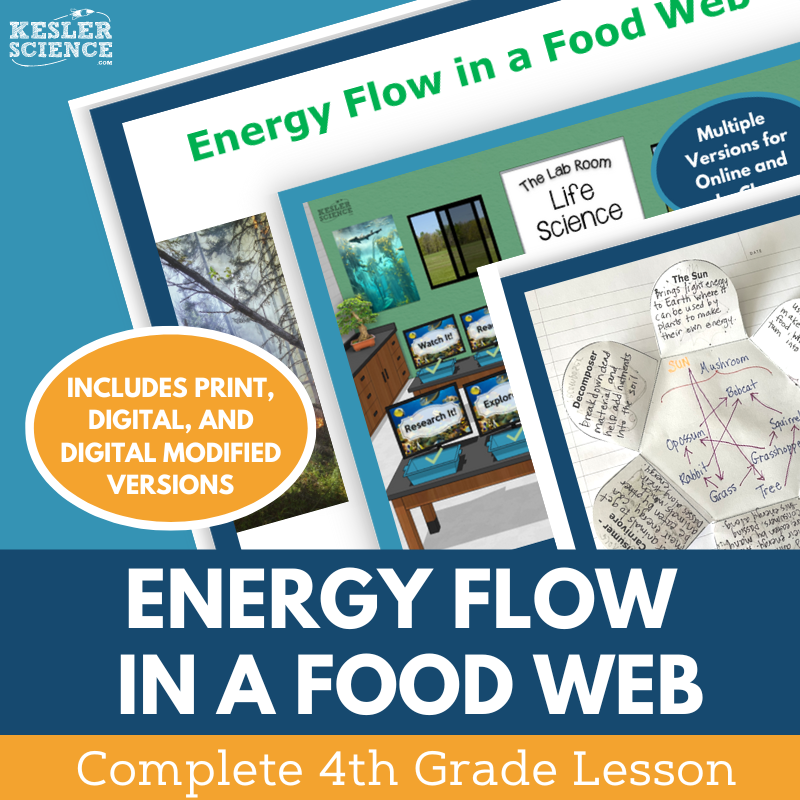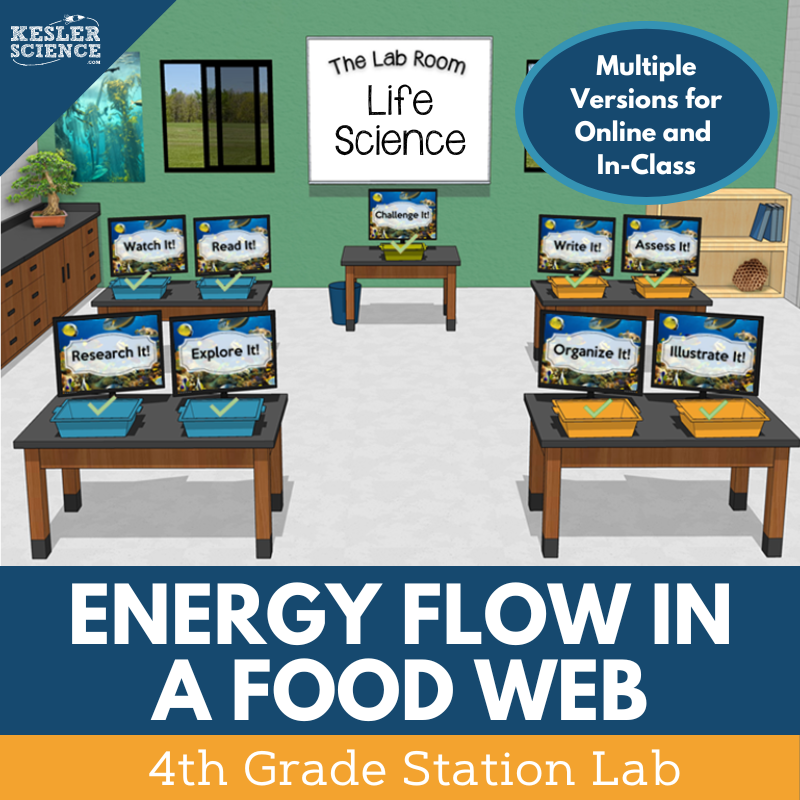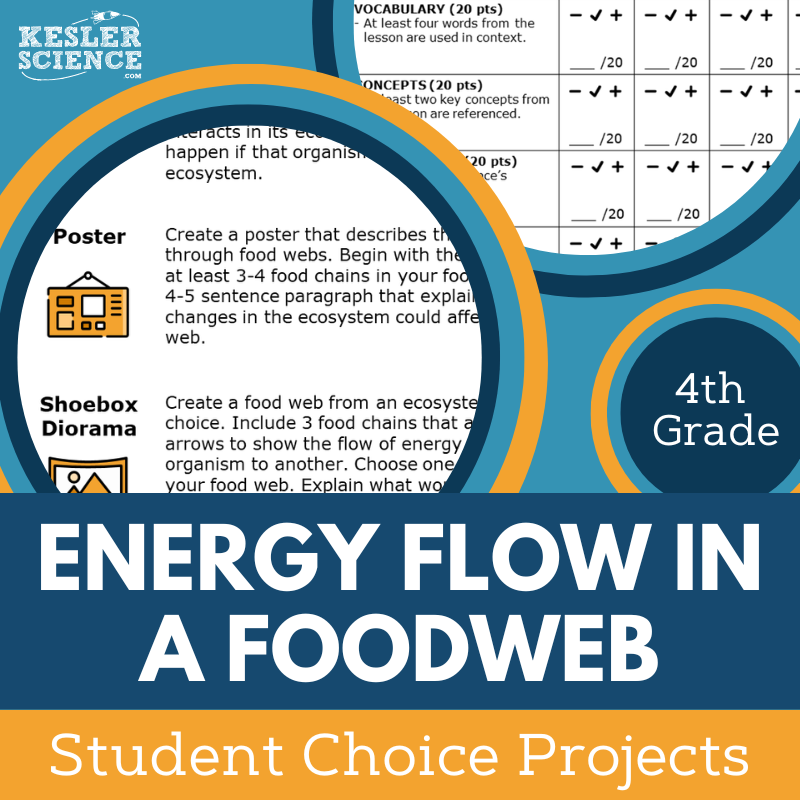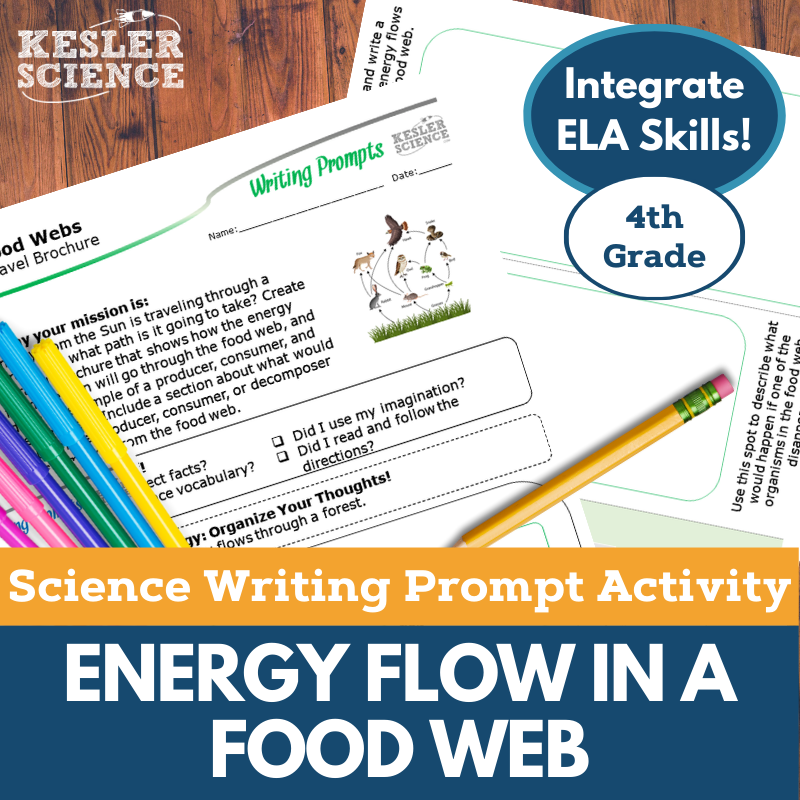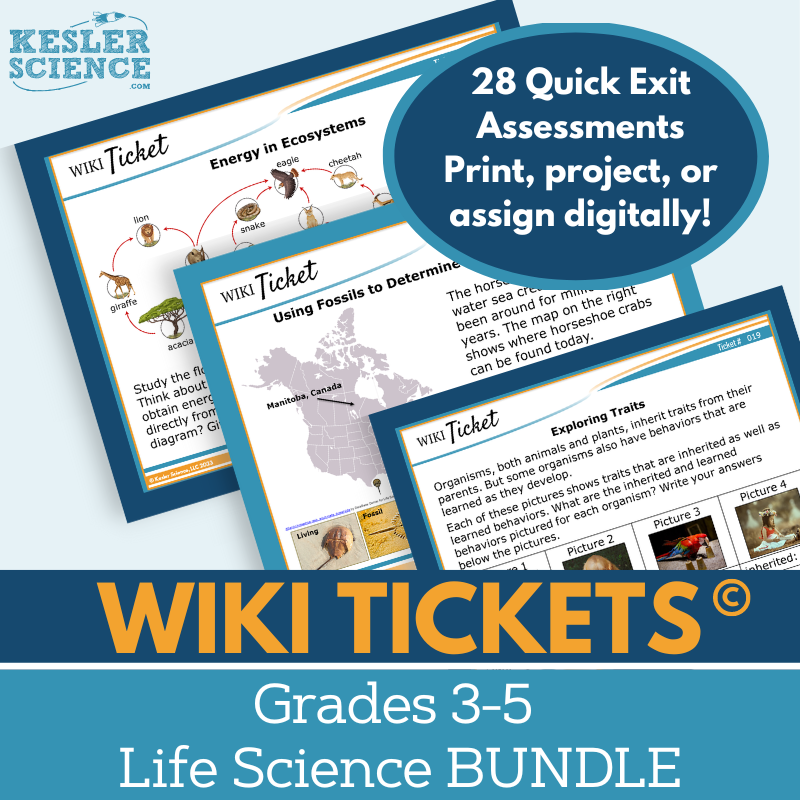Energy Flow in a Food Web Activities for 4th Grade Science
The Kesler Science Energy Flow in a Food Web resources provides a student-centered approach to teaching how energy flows through food webs. The resources below will give students a comprehensive understanding of food webs. All of the following materials are also included in the Kesler Science Membership.
The Kesler Science Energy Flow in a Food Web 4th Grade Complete 5E Lesson equips you with everything needed to teach a comprehensive, student-driven lesson on how energy flows through food webs. Designed for minimal prep, this resource empowers students to direct their own learning while you focus on their success.
Students will engage with essential questions like "How does energy flow through a food web?" and "How do changes in ecosystems affect these webs?" With differentiated resources, multimodal learning options, and flexible formats, this lesson caters to all learners, whether in-class or remote. Spanish translations ensure accessibility for all students.
The 5E Model covers all stages of learning, from engaging discussions with objectives and word wall cards, to interactive stations like hands-on activities, research, and multimedia content. Editable PowerPoints, interactive notebook templates, and assessment tools are all included to maximize flexibility and support student understanding of energy flow in ecosystems.
The Kesler Science Energy Flow in a Food Web 4th Grade Complete 5E Lesson equips you with everything needed to teach a comprehensive, student-driven lesson on how energy flows through food webs. Designed for minimal prep, this resource empowers students to direct their own learning while you focus on their success.
Students will engage with essential questions like "How does energy flow through a food web?" and "How do changes in ecosystems affect these webs?" With differentiated resources, multimodal learning options, and flexible formats, this lesson caters to all learners, whether in-class or remote. Spanish translations ensure accessibility for all students.
The 5E Model covers all stages of learning, from engaging discussions with objectives and word wall cards, to interactive stations like hands-on activities, research, and multimedia content. Editable PowerPoints, interactive notebook templates, and assessment tools are all included to maximize flexibility and support student understanding of energy flow in ecosystems.
The Kesler Science Energy Flow in a Food Web Station Lab offers a dynamic, student-led learning experience for 4th grade students to explore how energy flows through food webs, starting with the Sun. This modular, differentiated resource is designed to save prep time while encouraging independent learning.
With eight differentiated stations, plus a challenge station for early finishers, the lab covers various learning styles. Students engage with input stations like hands-on demos, reading passages, websites, and videos, and demonstrate their understanding through output stations such as organizing information, sketching, writing, and assessing their knowledge.
Designed for flexibility, these stations include all the necessary materials—signage, task cards, and resources—for both in-person and virtual environments. The stations encourage active learning and provide opportunities for students to apply and share their understanding of energy flow in food webs.
The Kesler Science Energy Flow in a Food Web Station Lab offers a dynamic, student-led learning experience for 4th grade students to explore how energy flows through food webs, starting with the Sun. This modular, differentiated resource is designed to save prep time while encouraging independent learning.
With eight differentiated stations, plus a challenge station for early finishers, the lab covers various learning styles. Students engage with input stations like hands-on demos, reading passages, websites, and videos, and demonstrate their understanding through output stations such as organizing information, sketching, writing, and assessing their knowledge.
Designed for flexibility, these stations include all the necessary materials—signage, task cards, and resources—for both in-person and virtual environments. The stations encourage active learning and provide opportunities for students to apply and share their understanding of energy flow in food webs.
The Kesler Science Energy Flow in a Food Web Student Choice Projects give 4th grade students the flexibility to choose from six project options or create their own. The grading rubric allows for assessments by teachers, peers, or students themselves, making the process adaptable to various learning styles.
These dynamic projects offer nine options, plus a "design your own" project, and include a teacher directions page with support and suggestions. The editable rubric assesses key areas like vocabulary, concepts, presentation, clarity, and accuracy, making it easy to modify for different needs.
Differentiated for students at various levels, these projects feature two versions: a modified version for students needing support and more advanced options for students seeking a challenge. The projects use basic classroom supplies, with many options adaptable for digital learning. Some crafting materials may be helpful for model-building projects.
The Kesler Science Energy Flow in a Food Web Student Choice Projects give 4th grade students the flexibility to choose from six project options or create their own. The grading rubric allows for assessments by teachers, peers, or students themselves, making the process adaptable to various learning styles.
These dynamic projects offer nine options, plus a "design your own" project, and include a teacher directions page with support and suggestions. The editable rubric assesses key areas like vocabulary, concepts, presentation, clarity, and accuracy, making it easy to modify for different needs.
Differentiated for students at various levels, these projects feature two versions: a modified version for students needing support and more advanced options for students seeking a challenge. The projects use basic classroom supplies, with many options adaptable for digital learning. Some crafting materials may be helpful for model-building projects.
The Kesler Science Energy Flow in a Food Web Science and ELA Integrated Writing Activity engages 4th grade students in learning about the Sun’s energy flow through food webs by having them create a travel brochure. This fun activity promotes science reasoning while allowing students to creatively demonstrate their knowledge through writing. It is designed for virtual learning, so your students can remain engaged even outside the classroom.
Aligned with TEKS and NGSS standards, this low-prep activity is perfect for elaboration or review and can be easily incorporated with other Kesler Science resources. Students will explore the topic of energy flow in a food web through a travel brochure format, allowing them to express their understanding in an interactive and creative way.
The activity includes teacher directions, project ideas, full and half-sheet rubrics, and a digital interactive version. It also offers flexibility with printable handouts, projection options, and the ability to complete the task digitally via PowerPoint or Google Slides, making it ideal for both in-person and remote learners.
The Kesler Science Energy Flow in a Food Web Science and ELA Integrated Writing Activity engages 4th grade students in learning about the Sun’s energy flow through food webs by having them create a travel brochure. This fun activity promotes science reasoning while allowing students to creatively demonstrate their knowledge through writing. It is designed for virtual learning, so your students can remain engaged even outside the classroom.
Aligned with TEKS and NGSS standards, this low-prep activity is perfect for elaboration or review and can be easily incorporated with other Kesler Science resources. Students will explore the topic of energy flow in a food web through a travel brochure format, allowing them to express their understanding in an interactive and creative way.
The activity includes teacher directions, project ideas, full and half-sheet rubrics, and a digital interactive version. It also offers flexibility with printable handouts, projection options, and the ability to complete the task digitally via PowerPoint or Google Slides, making it ideal for both in-person and remote learners.
The Kesler Science Life Science WIKI Tickets provide fun, easy formative assessments for 3rd–5th grade science. This set includes 28 engaging exit tickets aligned to NGSS and TEKS, covering topics like ecosystems, traits, life cycles, and food webs.
Each topic features five formats: a full-screen display for projection, three printable handout sizes, and an interactive digital version compatible with PowerPoint and Google Slides. A bonus table of contents file ensures easy standard alignment.
WIKI Tickets (“What I Know Is”) serve as exit tickets, bellringers, or quick checks for understanding, making them a flexible tool for both in-person and virtual learning environments.
The Kesler Science Life Science WIKI Tickets provide fun, easy formative assessments for 3rd–5th grade science. This set includes 28 engaging exit tickets aligned to NGSS and TEKS, covering topics like ecosystems, traits, life cycles, and food webs.
Each topic features five formats: a full-screen display for projection, three printable handout sizes, and an interactive digital version compatible with PowerPoint and Google Slides. A bonus table of contents file ensures easy standard alignment.
WIKI Tickets (“What I Know Is”) serve as exit tickets, bellringers, or quick checks for understanding, making them a flexible tool for both in-person and virtual learning environments.
Year-Round Resources
These year-round activities will increase your students' understanding of many middle school science topics. All of these activities are also included in the Kesler Science Membership.
Visual Data & Graphing
You're not alone if your students struggle with understanding graphs, charts, and tables. It's a skill that takes an enormous amount of practice. This resource will help students build a strong foundation in analyzing data and creating their own data visualizations.
Bell Ringers and Warm-Ups
These middle school science bell ringers are an excellent way to engage your students as soon as they walk into your classroom. This comprehensive FULL YEAR resource includes everything you need to start off each science class with an interesting warm-up activity.
Review Board Games
Each game board has been carefully designed to keep students engaged. There are 10 different action spaces on each board and dozens of question cards. All of the actions are related to science concepts and keep the students motivated throughout the game.
Each game is ready to play. Simply print out the board and the cards and let the students enjoy reviewing nine different units.
Essential Questions
Below are the essential questions associated with the lessons and activities included in this unit. This topic is only one of more than 100 middle school science topics included in the Kesler Science Membership.
-
How does energy flow through a food web?
-
How do changes in an ecosystem impact food webs?
Kesler Science Membership
Imagine never having to search for another middle school science lesson again. The membership gives you access to ALL of the Kesler Science products in one place (Yes, including everything above).
Say goodbye to long hours of lesson prep.

